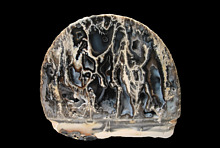Home PageAbout MindatThe Mindat ManualHistory of MindatCopyright StatusWho We AreContact UsAdvertise on Mindat
Donate to MindatCorporate SponsorshipSponsor a PageSponsored PagesMindat AdvertisersAdvertise on Mindat
Learning CenterWhat is a mineral?The most common minerals on earthInformation for EducatorsMindat ArticlesThe ElementsThe Rock H. Currier Digital LibraryGeologic Time
Minerals by PropertiesMinerals by ChemistryAdvanced Locality SearchRandom MineralRandom LocalitySearch by minIDLocalities Near MeSearch ArticlesSearch GlossaryMore Search Options
The Mindat ManualAdd a New PhotoRate PhotosLocality Edit ReportCoordinate Completion ReportAdd Glossary Item
Mining CompaniesStatisticsUsersMineral MuseumsClubs & OrganizationsMineral Shows & EventsThe Mindat DirectoryDevice SettingsThe Mineral Quiz
Photo SearchPhoto GalleriesSearch by ColorNew Photos TodayNew Photos YesterdayMembers' Photo GalleriesPast Photo of the Day GalleryPhotography
╳Discussions
💬 Home🔎 Search📅 LatestGroups
EducationOpen discussion area.Fakes & FraudsOpen discussion area.Field CollectingOpen discussion area.FossilsOpen discussion area.Gems and GemologyOpen discussion area.GeneralOpen discussion area.How to ContributeOpen discussion area.Identity HelpOpen discussion area.Improving Mindat.orgOpen discussion area.LocalitiesOpen discussion area.Lost and Stolen SpecimensOpen discussion area.MarketplaceOpen discussion area.MeteoritesOpen discussion area.Mindat ProductsOpen discussion area.Mineral ExchangesOpen discussion area.Mineral PhotographyOpen discussion area.Mineral ShowsOpen discussion area.Mineralogical ClassificationOpen discussion area.Mineralogy CourseOpen discussion area.MineralsOpen discussion area.Minerals and MuseumsOpen discussion area.PhotosOpen discussion area.Techniques for CollectorsOpen discussion area.The Rock H. Currier Digital LibraryOpen discussion area.UV MineralsOpen discussion area.Recent Images in Discussions
Identity HelpUnknown Plumas Co. Ca. rock

1st Aug 2020 05:21 UTCBrad von Dessonneck
Hello all,
I recently found this rock in a pegmatite in Plumas County, California, near Antelope Valley Reservoir. I am thinking that it is quartz (lt brn/clear) and possible garnet or rutile (dark red) oriented in the same direction. Possibly due to parallel growth. There is a dark red crystal that I believe is a garnet in the photo (lower left side), and minor plagioclase.
The piece is about 5 cm long and the rough specific gravity is about 3.21. It was found in a quartz vein with plagioclase and minor dark mica. Rose quartz is also known from this area. The host rock is a granodiorite.
Thanks!

1st Aug 2020 05:25 UTCBrad von Dessonneck


1st Aug 2020 06:38 UTCHerwig Pelckmans
Hi Brad,
Contrary to popular believe, even small grains can be used to do a hardness test.
Here is how:
You only need one small grain and a scratch free surface of for example a knife blade.
Hold the knife blade horizontal and mark a small (scratch free!) area with a permanent marker. Then put the grain on the knife blade and put one of your fingers on top of the grain. Now push hard on the grain and slide it back and forth over the blade a few times. Remove the grain (put it somewhere safe for other tests) and wash off the knife blade. Then look with a hand lens to see if the grain has scratched the knife.
The remainder of the story, as well as the use of other materials with diffferent hardnesses, is obvious.
Also, isolate another grain of the unknown and crush it. Then pour the powder on a sheet of white paper and see what color the powder has. Let us know that color.
Cheers, Herwig
ACAM & MKA
1st Aug 2020 20:40 UTCSteve Federico

2nd Aug 2020 07:27 UTCHerwig Pelckmans
Sure you must be an expert in that!
Cheers, Herwig
ACAM & MKA (Belgium)

4th Aug 2020 01:47 UTCBrad von Dessonneck
Hi Herwig and Steve,
Thanks for the advice. It scratched a knife but not quartz, and the powder was a light reddish-brown (no blood!). It as difficult to separate such small crystal grains.
I am leaning towards rutile with quartz now, but my pegmatite mineralogy is not very strong.
Photo of a 1-2 mm wide grain.
Thanks again,
Brad




Mindat.org is an outreach project of the Hudson Institute of Mineralogy, a 501(c)(3) not-for-profit organization.
Copyright © mindat.org and the Hudson Institute of Mineralogy 1993-2024, except where stated. Most political location boundaries are © OpenStreetMap contributors. Mindat.org relies on the contributions of thousands of members and supporters. Founded in 2000 by Jolyon Ralph.
Privacy Policy - Terms & Conditions - Contact Us / DMCA issues - Report a bug/vulnerability Current server date and time: April 25, 2024 05:44:52
Copyright © mindat.org and the Hudson Institute of Mineralogy 1993-2024, except where stated. Most political location boundaries are © OpenStreetMap contributors. Mindat.org relies on the contributions of thousands of members and supporters. Founded in 2000 by Jolyon Ralph.
Privacy Policy - Terms & Conditions - Contact Us / DMCA issues - Report a bug/vulnerability Current server date and time: April 25, 2024 05:44:52














